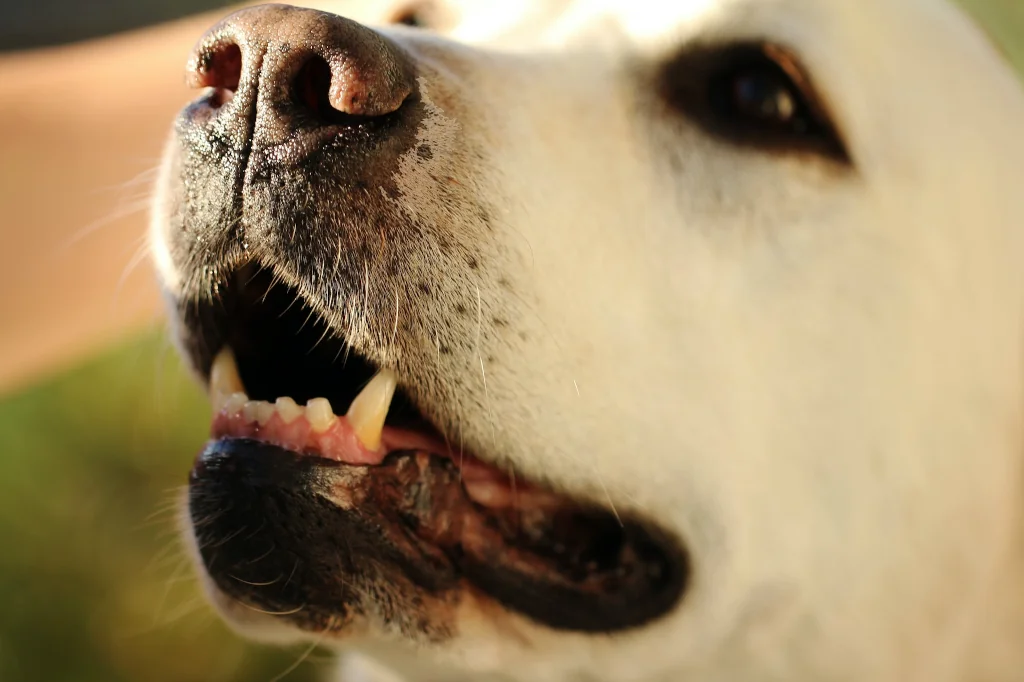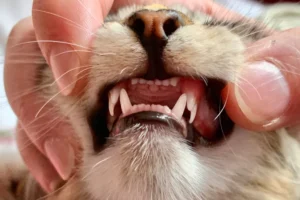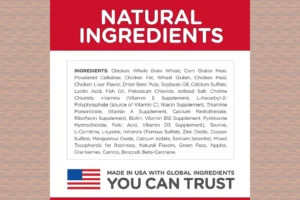Note: We may earn a commission from helpful, relevant links in our content. No cost to you. See our privacy policy.
Navigating the world of pet dental care?
That’s quite the endeavor! There’s a whole lot more to keeping those canine canines sparkly clean than you might imagine.
And it all starts with the choice of the right toothpaste. We’re all looking for that tail-wagging approval from our furry friends, but safety and effectiveness take the lead when it comes to oral care.
In this guide, we dive into the specifics of dog toothpaste – what to choose, what to avoid, and even some natural alternatives. Get ready to level up your pet dental care game and put a sparkly smile on your pooch’s face!

Why Should You Use Dog-Specific Toothpaste?
There’s something you need to understand: Dog-specific toothpaste isn’t just a marketing gimmick. It’s actually a crucial part of your dog’s oral health care.
Dogs can’t spit toothpaste out like humans do, so they end up swallowing it. That’s why we need to ensure what they’re swallowing is safe for them. Dog-specific toothpaste is designed with this in mind. It’s non-foaming and usually safe for dogs to swallow, unlike most human toothpastes.
Plus, dog toothpaste often comes in flavors like beef or chicken, which are far more appealing to your canine companion than the minty freshness we humans prefer.
So, investing in a good quality dog toothpaste is not only a smart move for your dog’s dental health, but it can also make the brushing experience much more enjoyable for your four-legged friend. Remember, a happy dog with a clean mouth is a win-win situation!
What Ingredients to Look for in Dog Toothpaste?
Selecting the right toothpaste for your furry friend is just like picking the best food – the ingredients matter. The ideal dog toothpaste should help fight plaque and freshen breath, all while being safe for your pet to swallow. Here’s a quick guide on key ingredients to look for:
Enzymes
Enzymatic toothpaste for dogs contains enzymes like glucose oxidase or lactoperoxidase. These enzymes catalyze reactions that help break down plaque and reduce harmful bacteria in your dog’s mouth. They are gentle yet effective, making them an excellent ingredient to look for.
Silica
Silica is a mild abrasive that helps remove plaque and tartar buildup on your dog’s teeth. It’s gentle enough not to damage the tooth enamel, making it a safe and efficient ingredient.
Sorbitol
While it’s not a cleaning agent, sorbitol adds sweetness to the toothpaste, making it more appealing to your dog. It’s a safe sugar substitute that won’t contribute to tooth decay.
Flavors (natural)
Sure, it’s not an active cleaning ingredient, but the flavor of the toothpaste can greatly influence how well your dog cooperates during brushing time. Look for dog-friendly flavors like poultry, beef, or peanut.
While flavors enhance palatability, it’s also crucial they are naturally derived, meaning those sourced directly from food items like chicken or peanuts. Check the ingredient list – names you can recognize and pronounce usually indicate natural sources.
Natural Oils
Some toothpastes contain natural oils like neem oil, peppermint oil, or eucalyptus oil. These oils not only freshen your dog’s breath but may also possess antimicrobial properties.
To summarize, here’s a table of ingredients to look for in dog toothpaste:
| Ingredients | Why They’re Good |
| Enzymes | Help break down plaque and reduce harmful bacteria |
| Silica | Gently removes plaque and tartar |
| Sorbitol | Adds sweetness, safe sugar substitute |
| Natural Flavors (beef, poultry, peanut) | Make toothpaste appealing to dogs |
| Natural Oils (neem, peppermint, eucalyptus) | Freshen breath, may have antimicrobial properties |
With those in mind, Virbac C.E.T. Enzymatic Toothpaste is a solid choice for your dog’s oral care. It contains beneficial enzymes that work to reduce plaque and tartar build-up, ensuring a cleaner and healthier mouth for your dog. Its poultry flavor is typically well-received by dogs, making brushing a more enjoyable experience.
Speaking from personal experience, having the right toothpaste does make a difference. My older German Shepherd, Sam, was never keen on tooth brushing. The sight of the toothbrush would send him hiding. But when I switched to the Virbac C.E.T. Enzymatic Toothpaste, things changed dramatically. Its poultry flavor was a hit, and to my surprise, Sam actually looked forward to our brushing sessions! The improvement in his oral health was undeniable too. His teeth looked cleaner, his breath was fresher, and his gums healthier. Try it out for yourself here.
Remember, a good dog toothpaste doesn’t just clean teeth – it makes the brushing experience pleasant for both you and your pooch. So keep these ingredients in mind as you navigate the pet oral care aisle.
Which Ingredients to Avoid?
Just as important as knowing what should be in your dog’s toothpaste, is understanding what should not. Certain ingredients commonly found in human toothpaste can be harmful, even toxic, to dogs. Here’s a list of ingredients you should steer clear of when choosing a toothpaste for your canine companion:
Xylitol
This sweetener is often found in sugar-free products, including some toothpastes. While safe for humans, xylitol is extremely toxic to dogs, causing a rapid drop in blood sugar and potentially leading to liver failure.
Fluoride
While fluoride is beneficial for humans, it’s not safe for dogs, especially in the quantities found in human toothpaste. Ingesting fluoride can lead to digestive problems, restlessness, excessive drooling, and more severe symptoms in dogs.
Sodium Lauryl Sulfate (SLS)
This is a foaming agent used in many human toothpastes. Dogs can’t rinse and spit like we do, so they end up swallowing the toothpaste. This can lead to stomach upset or even diarrhea.
Artificial Colors and Flavors
These might make the toothpaste look or taste better, but they don’t add any benefits to your dog’s dental health. Furthermore, some dogs may be allergic to these additives, leading to unnecessary health problems. Opt for natural colors and flavors.
Synthetic flavors and colors often have chemical names or numbers listed in the ingredients. If you see those in the ingredient listed on a dog toothpaste, choose a different one if you can.
Alcohol
Alcohol is used in some human toothpastes as a carrier for the other ingredients. It can cause digestive problems and even intoxication in dogs.
To summarize, here are the ingredients to avoid in dog toothpaste:
| Ingredients | Why They’re Bad |
| Xylitol | Toxic to dogs, can lead to liver failure |
| Fluoride | Not safe for dogs, can lead to various health problems |
| Sodium Lauryl Sulfate (SLS) | Can cause stomach upset or diarrhea |
| Artificial Colors and Flavors | Add no benefits, some dogs may be allergic |
| Alcohol | Can cause digestive problems and intoxication |
When it comes to your dog’s toothpaste, remember that less is often more. Opt for products with a simple ingredient list and stay clear of those that contain the harmful components listed above. Prioritize your dog’s safety and health, and you’ll both have a reason to smile!

How to Choose the Right Toothpaste for Your Dog
Selecting the right toothpaste for your dog involves a bit more than grabbing the first tube off the shelf. To ensure you’re choosing a product that’s both effective and safe, follow this simple guide:
1. Consider Your Dog’s Preferences
Does your dog turn his nose up at the smell of mint, but wag his tail at the scent of beef? Opt for a toothpaste in a flavor your pet loves. It’ll make the teeth-cleaning process more enjoyable for both of you.
Check your dog’s reaction post-brushing. If they drool excessively or paw at their mouth, it could indicate discomfort, implying the need to switch toothpaste.
2. Examine the Ingredient List
Look for the beneficial ingredients we mentioned earlier like enzymes, silica, and sorbitol. Avoid potentially harmful substances such as xylitol, fluoride, and SLS. And remember, fewer ingredients are usually better when it comes to dog toothpaste.
Extra Tip: In addition to checking the ingredients, pay attention to the order in which they’re listed. The ingredients at the top of the list are present in higher amounts.
3. Check for Veterinary Approval
Many toothpaste brands feature a seal of approval from a veterinary association. This seal means the toothpaste has met specific safety and effectiveness standards. While not all good products have this seal, it can provide an extra layer of reassurance.
For instance, Petrodex Enzymatic Toothpaste for Dogs is a popular choice among dog owners and vets alike. Recognized for its effective enzymatic action, it’s not only brilliant at preventing tooth decay and controlling bad breath, but also has the stamp of approval from veterinary associations. Moreover, its poultry flavor is a hit with most dogs, turning tooth brushing from a chore into a treat. Check it out here.
4. Consider the Type of Toothpaste
There are different types of dog toothpaste available – gels, pastes, or even sprays. While gels and pastes are typically more effective for a thorough clean, sprays can be a good option if your dog isn’t a fan of the brushing process.
Extra Tip: Consider a gradual approach when introducing a new toothpaste form, especially if it’s a spray. Allow your dog to get used to the new form slowly to make the transition smoother.
5. Take into Account Your Dog’s Specific Needs
If your dog has a particular dental issue like gingivitis or a history of tartar build-up, look for a toothpaste specifically designed to address these problems.
And if your dog shows signs of tooth sensitivity or discomfort during brushing, consult your vet immediately. There could be an underlying dental issue that requires a specialized type of toothpaste or even medical attention.
Remember, choosing the right toothpaste for your furry friend isn’t rocket science. It requires a little attention to detail and consideration for your dog’s preferences and needs. By following this guide, you’ll be able to find a toothpaste that works for both you and your dog, making tooth brushing time a more positive experience.
Any Natural Alternatives for Dog Toothpaste?
Not all dogs accept the idea of tooth brushing with open paws, and sometimes, you might just run out of your favorite canine toothpaste. In these cases, knowing some natural alternatives can come in handy:
- Coconut Oil. Coconut oil is a popular choice among pet owners due to its natural antibacterial and antifungal properties. Plus, many dogs love the taste! You can apply it with a toothbrush, or even let your dog lick it off your finger. Remember, moderation is key, as coconut oil is high in calories.
- Baking Soda and Water. A mixture of baking soda and water can act as a temporary substitute for dog toothpaste. While not as effective as a commercial product, it can help freshen your dog’s breath and reduce plaque. However, ensure that your dog does not swallow this mixture, as baking soda can disrupt their electrolyte balance.
- Turmeric Paste. Not many pet owners know about this, but turmeric paste is an effective and safe alternative. Turmeric has anti-inflammatory, antioxidant, and antibacterial properties, which can support oral health. Just mix a bit of turmeric with water, and you’re good to go.
Remember, while these alternatives can help in a pinch, they shouldn’t replace specially formulated dog toothpaste for regular use. Commercial dog toothpaste is specifically designed to address canine oral health issues and is typically the best choice for maintaining your dog’s dental health.
Now that you’re armed with this knowledge, it’s time to make the leap and choose the right toothpaste for your furry friend. Remember, good oral hygiene is just as important for your pet as it is for you. And the best part? Armed with the right toothpaste, brushing your dog’s teeth can turn into a bonding activity, full of tail wags and smiles!
Dog toothpastes we trust:
FAQs
What toothpaste is OK for dogs?
Toothpaste specially formulated for dogs, which does not contain harmful ingredients like xylitol, fluoride, or SLS, is OK for dogs. Look for flavors your dog enjoys to make the process easier.
Is it okay to use human toothpaste on dogs?
It is not safe to use human toothpaste on dogs. Many human toothpastes contain fluoride, which is harmful to dogs, and artificial sweeteners like xylitol, which can be fatal.
Can I use cat toothpaste on my dog?
Unless the toothpaste was created specifically in mind for both dogs and cats, using cat toothpaste on a dog is not typically advised. Each species has different oral care requirements and may react differently to ingredients. Always use toothpaste specifically formulated for dogs.
How often should I brush my dog’s teeth?
To maintain good oral health, it’s recommended to brush your dog’s teeth at least 2-3 times per week. However, daily brushing is ideal for the best dental health.
Do you always need to put toothpaste on?
While it’s possible to brush your dog’s teeth without toothpaste, using a dog-specific toothpaste will significantly improve the effectiveness of brushing by helping to remove plaque and freshen their breath.
Can I brush my dog’s teeth with baking soda?
Baking soda can be used to brush a dog’s teeth, but it should be used sparingly, and the dog should not swallow it. Too much baking soda can disrupt a dog’s electrolyte balance and cause stomach upset.
Alex, a passionate animal lover, has experience in training and understanding animal behavior. As a proud pet parent to two dogs and three cats, he founded AnimalReport.net to share insights from animal experts and expand his knowledge of the animal kingdom.









